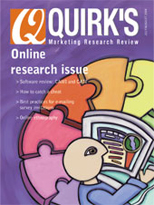Editor’s note: Linda Binder is senior vice president and moderator-consultant at Primary Insights, Inc., a Lisle, Ill., research firm.
Much has been said in the marketing press recently about the variety of ways in which companies have enhanced their qualitative experience by bringing clients directly in contact with consumers. Comp-anies such as Quaker Oats, Procter & Gamble and Nickelodeon have been featured in marketing research seminars and articles on the topic.
This is not a revolutionary change in how qualitative is conducted. It is an evolutionary adaptation of methods. It makes sense given changes in the marketplace today. There is increasing need among clients for in-depth understanding of their consumers. Market segments are becoming even more fragmented, consumer behaviors are changing rapidly, and consumers are becoming more savvy and comfortable with marketing concepts and clients’ presence. Consumers want to know they are being listened to and appreciate having the backroom demystified.
At the same time, clients are having more difficulty learning when asked to observe through the mirror. They are increasingly expected to multitask - to keep on top of events in the office while sitting in the back room. They are expected to listen and observe while checking e-mails and being repeatedly interrupted by phone calls. As a result, instead of learning fully, they are listening halfheartedly.
Bringing clients together with consumers allows clients to focus on the issues at hand for more effective learning. It keeps them more involved and mentally stimulated. It enables them to follow up with consumers in real time - rather than having to pass notes to the moderator. It allows clients to be fully present, to truly experience the sessions with their senses rather than through filtered visual and auditory observation only.
Not a new idea
The idea of bringing clients and consumers face to face - without the anonymity of the two-way mirror - is not new. In the past, clients have informally interviewed consumers outside the office and been present during observational interviews. Some routinely join moderator-consultants in the focus group room to observe and ask questions. Our firm has been involving clients in the interviewing room for years, and we often introduce clients to consumers by showing respondents who is behind the mirror.
Eliminating the mirror is becoming more mainstream. Clients are encouraged to examine ways of getting closer to consumers. This might be as simple as joining the moderator for the entire focus group or IDI session. It may be as dramatic as facilitated…
…joint client-consumer ideation sessions;
…client-led subgroups of consumers within the context of a larger qualitative session; or
…day-long or weekend-long sessions in which clients and consumers work together.
There are several aspects to consider when deciding if, when and how to bring clients and consumers face-to-face.
- Study purpose. If client team members have a strong vested interest in a specific outcome, it might be best to keep clients in the backroom. If the study’s purpose is one of exploration and/or ideation, there may be benefits to bringing parties together.
- Personalities involved. Clients who meet with consumers must be open, non-judgmental and non-leading in their language and nonverbal cues. They must be completely involved when with consumers - and be neither intimidated nor intimidating.
- Topics involved. Some clients are uncomfortable meeting consumers face-to-face if the topic is personal in nature. However, we would encourage you to challenge your assumptions.
- Commitment. Becoming involved with consumers takes time. It requires training up front, full commitment of mind and body during the sessions and extensive debriefing to allow everyone to share their insights. It is not uncommon for joint client-consumer sessions to require three-hour training meetings up front and three- to four-hour debriefing/working sessions at the end of the study.
Enhance learning
Dealing with consumers face to face can be a rewarding, unforgettable experience - and a wonderful way to enhance learning and qualitative insights. Under the guidance of a skilled researcher and facilitator - and with the appropriate study objectives - it brings clients a depth of learning that is unattainable from back room observation alone.
